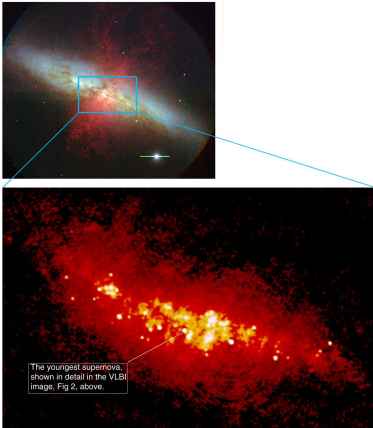|
The nearby galaxy M82 is currently undergoing a rapid phase
of star formation and is, as a result, called a Starburst Galaxy.
Most stars, like our own Sun, live for billions of years, but
a small number are tens of times more massive and evolve very
rapidly, living for only a few million years or so. When they
die, they do so in a spectacular fashion, blowing themselves
apart in a titanic explosion called a supernova. So, paradoxically,
the signature of such a region of star formation is the explosive
death of massive stars.
The
advantage of radio observations
Because
starburst galaxies like M82 contain a lot of obscuring dust
it is very difficult for optical telescopes to investigate the
regions of star formation. However, radio waves can pass unhindered
through the dust enabling radio astronomers to look right into
the violent heart of the galaxy.
Using
MERLIN, the Very Large Array and VLBI observations to study
M82
The
false colour image of the central region of M82 was made by
combining the data from the VLA with those from MERLIN to give
a map showing broad scale structure allied to great detail.
The peaks of radio emission, shown as white spots on the map,
indicate the sites of supernova remnants. Due to the great distance
of the galaxy (10 million light years) this map is not able
to resolve detail in the remnants but, knowing their precise
location, it was then possible to use global arrays of telescopes
to image them in unprecedented detail. They are seen to be expanding
shell-like clouds of gas shining brightly at radio wavelengths.
Comparing images of the same young supernovae made in 1986 and
1997, Jodrell Bank astronomers found that the shells of gas
are expanding at speeds of up to 20,000 km/s. The youngest supernova
exploded only about 35 years ago but, hidden behind a curtain
of dust, was never seen by optical telescopes.
The
evolution of supernovae
In
M82, radio astronomers have seen the evolution of the expanding
fireball from a supernovae explosion. As our own galaxy is now
in a relatively quiescent phase of star formation, there are
no young supernovae to observe close by, and thus these observations
of M82 give us a unique chance to study them in the early phase
of their evolution. This is important as it is thought that
most galaxies, including our own, have gone through a similar
phase of rapid star formation when the Universe was young. So,
by studying M82, we can learn about the early history of our
own galaxy, the Milky Way.

Subaru (top) and Merlin/VLA (bottom) images of the galaxy M82.
The radio image covbers the heart of the galaxy as shown by
the blue box overlaid onto the optical image. The white spots
are the supernova remnants.
Home
| U.Man | PPARC
| MERLIN | VLBI |
Search | Feedback
|
